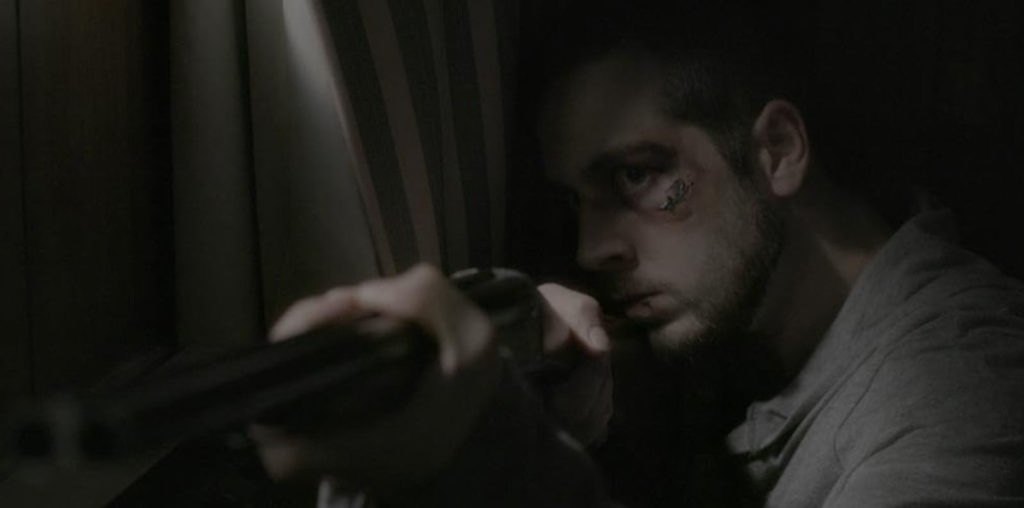
After the trials and tribulations of Gangs of New York, one would have thought that Martin Scorsese would have done something quick and on the cheap. But no, he’s leapt right back into the world of mega-budget historical spectacles with “The Aviator”, and thank god he did, as it’s an aggressive, overwhelming piece of work that raises the year’s cinematic G.P.A. all by itself.
Leonardo DiCaprio plays Howard Hughes, the scrawny Texas kid who leveraged the money from his family’s drill-bit company into a glamorous career as Hollywood powerhouse and aviation industrialist before going insane. With the exception of a brief prologue in which Hughes’s mother infects the kid with a lifelong fear of pestilence that would later fuel his germaphobia, the film covers the years from 1927 to 1947, when Hughes rocketed from success to success. John Logan’s punchy script starts in egomaniacal mayhem, with Hughes shooting his much-ballyhooed, much-delayed and self-financed World War I dogfight epic, “Hell’s Angels”, making up for his lack of filmmaking finesse with pitbull-like tenacity and damn-the-torpedos bravura that’s hard to resist. The “Titanic” of its day (a nice bit of verisimilitude for the star), the $4 million film was a smash when finally wrestled from Hughes’s hands and released three years later, setting Hughes up for the Hollywood high life (and the actresses that came with it) that became one of the three tentpoles of his life, the other two being aviation and an unhealthy obsession with cleanliness.
The first half of “The Aviator” is a blurred rush, with Hughes fairly bouncing through scene after scene as he romances famous women, produces controversial films (from “Scarface” to “The Front Page” and “The Outlaw”), invents new airplanes and breaks air speed records. Every second he’s on screen, DiCaprio shows that this is absolutely his film with a nervy and sublimely confident performance that should dispell any lingering Tom Cruise-ish heckling about a lack of serious actorly chops. The only thespian in Scorsese’s solid gold, A+-list cast who matches him is, not surprisingly, Cate Blanchett, in the seemingly thankless role of Katherine Hepburn, whose troubled romance with Hughes is the emotional heart of the film. Lippy and high-strung like a racehorse, Blanchett’s Hepburn is far from the expected caricature, it’s a full-fleshed embodiment that treats her as a real person and hardly some distant icon of Hollywood’s Golden Age. Having these two at the center of the film is emblematic of one of Scorsese’s smartest decisions, namely, using actual movie stars to play movie stars of the past – why settle for second-stringers when you can get Blanchett as Hepburn, Jude Law as Errol Flynn and Kate Beckinsale as Ava Gardner?
Later on, Hughes buys his own airline, TWA, setting up the final confrontation in the 1940s between his rogue operation and the forces of evil mediocrity, presented in cartoonish fashion by Alec Baldwin, as Juan Trippe, head of Pan Am, and Alan Alda, as Senator Brewster, who’s solidly in Trippe’s pocket. Many of the later sections detailing this corporate-government alliance’s attempts to give Pan Am a monopoly and stop the maverick Hughes (some unfortunate shades of Tucker here) falter somewhat, but any sense of staleness is swept clean away by Baldwin and Alda’s performances. The former turns in another installment of the ever-enjoyable Alec Baldwin Show – as the pugnacious and menacing but still semi-loveable bastard – while Alda plays the weaselly politician to the hilt, but with an unexpectedly waggish charm.
As big and rollicking an entertainment as it is, “The Aviator” deals smartly with its most problematic element, namely Hughes’s mental decline. Although we are spared the truly dark and reclusive final decades of his life (he died in 1976), the film stealthily mixes into the story Hughes’s steady deterioration. Although many of his problems – obsessive hand-washing, Tourette’s-like repetition of certain phrases – could have been played for comedy, they’re treated with surprising tenderness. By the end of the film, we see Hughes as less the freak that he has been often reduced to, but more a tragic figure who’s aware of his deteriorating condition but can do nothing to stop it, imprisoned by his own compulsions. While Hughes does get put through the wringer, both physically and emotionally, Scorsese seems to have lost the compulsion, evident in so many of his films, to utterly annihilate his protagonist.
With “The Aviator”, Scorsese has finally shown his ability to break free from his past, not that he necessarily needed to. From this point on, it’s possible he could end up being better known as a pop chronicler of American history (“Casino”, “Gangs of New York”) then as the avatar of gangster flicks and masochistic de Niro performances. This is Scorsese’s “Schindler’s List”, for better and for worse (mostly the better).
Disagree with this review? Think you can write a better one? Go right ahead in Film Threat’s BACK TALK section! Click here>>>
